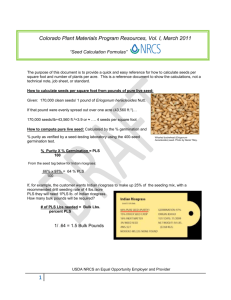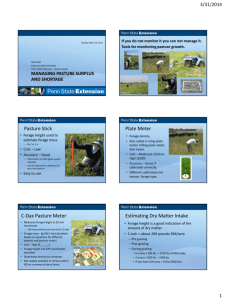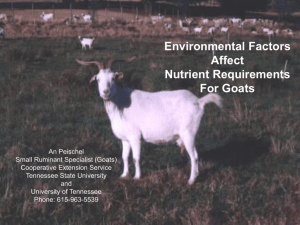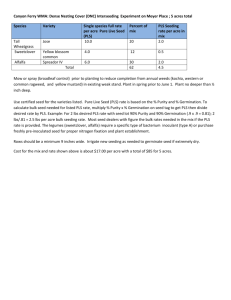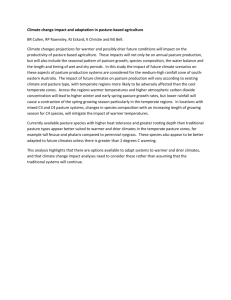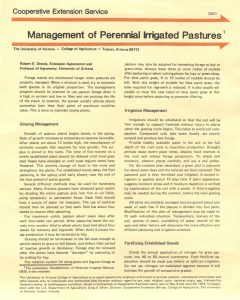Dryland Pasture for Horses
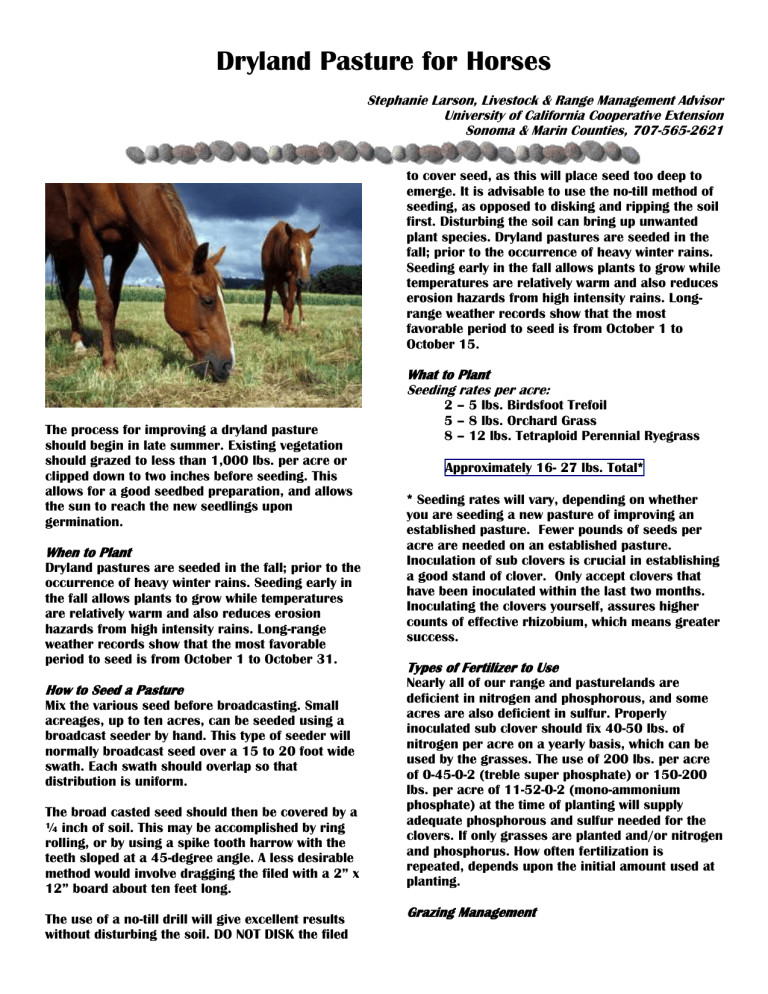
The process for improving a dryland pasture should begin in late summer. Existing vegetation should grazed to less than 1,000 lbs. per acre or clipped down to two inches before seeding. This allows for a good seedbed preparation, and allows the sun to reach the new seedlings upon germination.
When to Plant
Dryland pastures are seeded in the fall; prior to the occurrence of heavy winter rains. Seeding early in the fall allows plants to grow while temperatures are relatively warm and also reduces erosion hazards from high intensity rains. Long-range weather records show that the most favorable period to seed is from October 1 to October 31.
How to Seed a Pasture
Mix the various seed before broadcasting. Small acreages, up to ten acres, can be seeded using a broadcast seeder by hand. This type of seeder will normally broadcast seed over a 15 to 20 foot wide swath. Each swath should overlap so that distribution is uniform.
The broad casted seed should then be covered by a
¼ inch of soil. This may be accomplished by ring rolling, or by using a spike tooth harrow with the teeth sloped at a 45-degree angle. A less desirable method would involve dragging the filed with a 2” x
12” board about ten feet long.
The use of a no-till drill will give excellent results without disturbing the soil. DO NOT DISK the filed
Dryland Pasture for Horses
Stephanie Larson, Livestock & Range Management Advisor
University of California Cooperative Extension
Sonoma & Marin Counties, 707-565-2621
to cover seed, as this will place seed too deep to emerge. It is advisable to use the no-till method of seeding, as opposed to disking and ripping the soil first. Disturbing the soil can bring up unwanted plant species. Dryland pastures are seeded in the fall; prior to the occurrence of heavy winter rains.
Seeding early in the fall allows plants to grow while temperatures are relatively warm and also reduces erosion hazards from high intensity rains. Longrange weather records show that the most favorable period to seed is from October 1 to
October 15.
What to Plant
Seeding rates per acre:
2 – 5 lbs. Birdsfoot Trefoil
5 – 8 lbs. Orchard Grass
8 – 12 lbs. Tetraploid Perennial Ryegrass
Approximately 16- 27 lbs. Total*
* Seeding rates will vary, depending on whether you are seeding a new pasture of improving an established pasture. Fewer pounds of seeds per acre are needed on an established pasture.
Inoculation of sub clovers is crucial in establishing a good stand of clover. Only accept clovers that have been inoculated within the last two months.
Inoculating the clovers yourself, assures higher counts of effective rhizobium, which means greater success.
Types of Fertilizer to Use
Nearly all of our range and pasturelands are deficient in nitrogen and phosphorous, and some acres are also deficient in sulfur. Properly inoculated sub clover should fix 40-50 lbs. of nitrogen per acre on a yearly basis, which can be used by the grasses. The use of 200 lbs. per acre of 0-45-0-2 (treble super phosphate) or 150-200 lbs. per acre of 11-52-0-2 (mono-ammonium phosphate) at the time of planting will supply adequate phosphorous and sulfur needed for the clovers. If only grasses are planted and/or nitrogen and phosphorus. How often fertilization is repeated, depends upon the initial amount used at planting.
Grazing Management
Carefully control grazing the first year of pasture establishment, especially when soil is wet. Light grazing is recommended three to four months after seeding whenever the soil is firm. It is important to remove the grasses during the winter, thus allowing the sun to penetrate to the clovers. If subterranean clovers are shaded by the grasses early in growth, they will not grow properly and could be lost. Yields from a newly seeded pasture will be approximately 60 percent of future yield.
An important part of grazing management is implementing a controlled rotation grazing system that allows plants to rest and re-grow. Pastures should be managed to maintain animal health requirements while maintaining the needs of a new pasture.
What Type of Soil is Required?
Most soils that are 18 to 24 inches deep will grow satisfactory dryland pastures. Soils less than 18 inches deep will produce less forage because the soil moisture is exhausted sooner following the last spring rains.
Use of Supplemental Feed on Pasture
Supplemental feeding during certain periods will increase the utilization of the forage produced.
Alfalfa hay, oat hay, or other appropriate food sources fed during the winter and summer months, may be necessary to need the nutritional requirements of livestock.
Quality of Forage from Pasture
The quality of forage produced is superior to most of native pastures. Sub clover has a high percent of crude protein when green and will contain up to 12 percent crude protein in the mature, dry stage.
Acres Needed per Animal Unit
An animal unit is a 1,000 pound animal and usually a horse is equivalent to 1.4 animal unit.
An animal will consume approximately 2 – 3 % of its body weight per day, depending on its nutritional requirements. Therefore, on average, a horse will require 1,050 pounds of forage per month or six tons of hay or its forage equivalent on a yearly basis. Depending on the management of the pastures, an acre of irrigated pasture can produce enough forage to carry one horse for the entire year.
The University of California prohibits discrimination or harassment of any person on the basis of race, color, national origin, religion, sex, gender identity, pregnancy (including childbirth, and medical conditions related to pregnancy or childbirth), physical or mental disability, medical condition (cancer-related or genetic characteristics), ancestry, marital status, age, sexual orientation, citizenship, or service in the uniformed services (as defined by the
Uniformed Services Employment and Reemployment Rights Act of 1994: service in the uniformed services includes membership, application for membership, performance of service, application for service, or obligation for service in the uniformed services) in any of its programs or activities. University policy also prohibits reprisal or retaliation against any person in any of its programs or activities for making a complaint of discrimination or sexual harassment or for using or participating in the investigation or resolution process of any such complaint. University policy is intended to be consistent with the provisions of applicable
State and Federal laws. Inquiries regarding the University’s nondiscrimination policies may be directed to the Affirmative Action/Equal Opportunity Director, University of California,
Agriculture and Natural Resources, 1111 Franklin Street, 6 th Floor, Oakland, CA 94607, (510)
987-0096.
Handout revised: 10/2009




